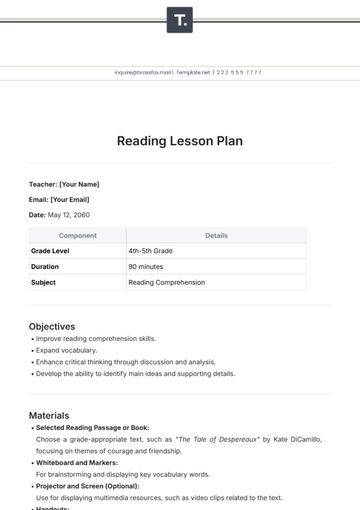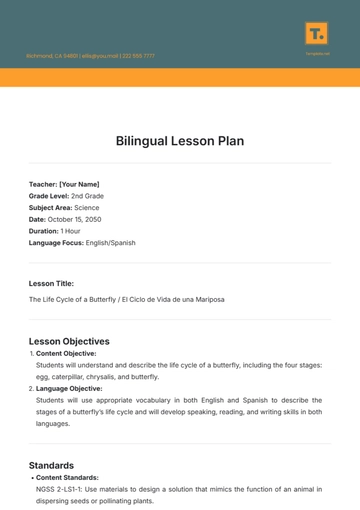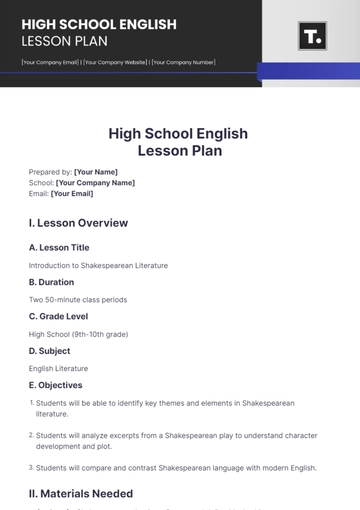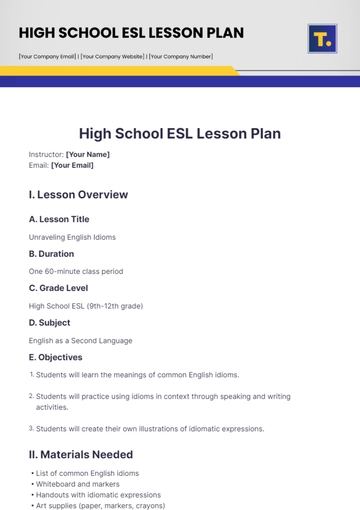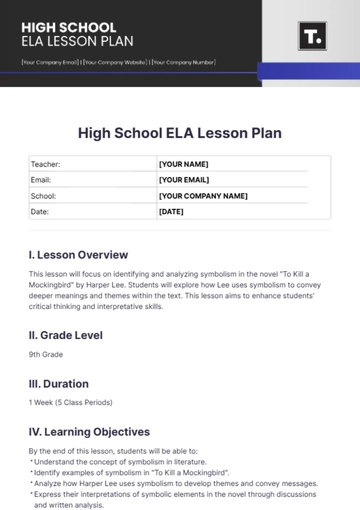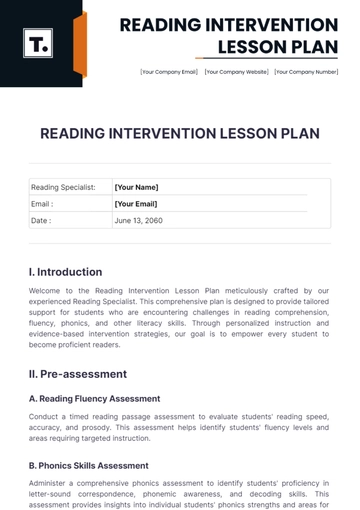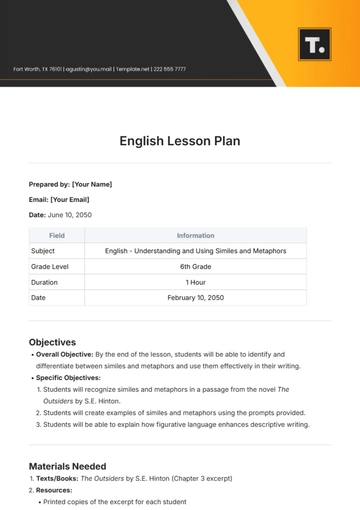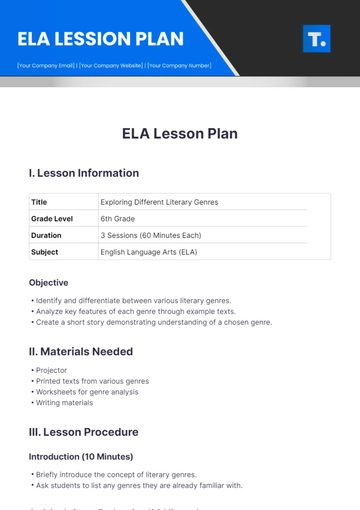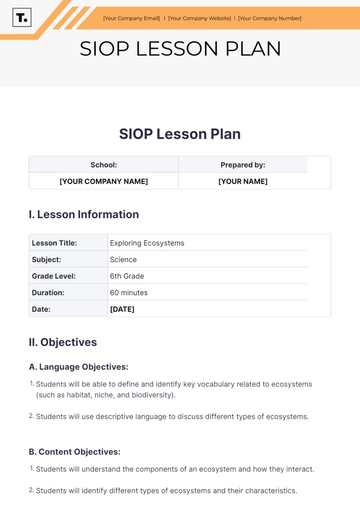Free English Lesson Plan
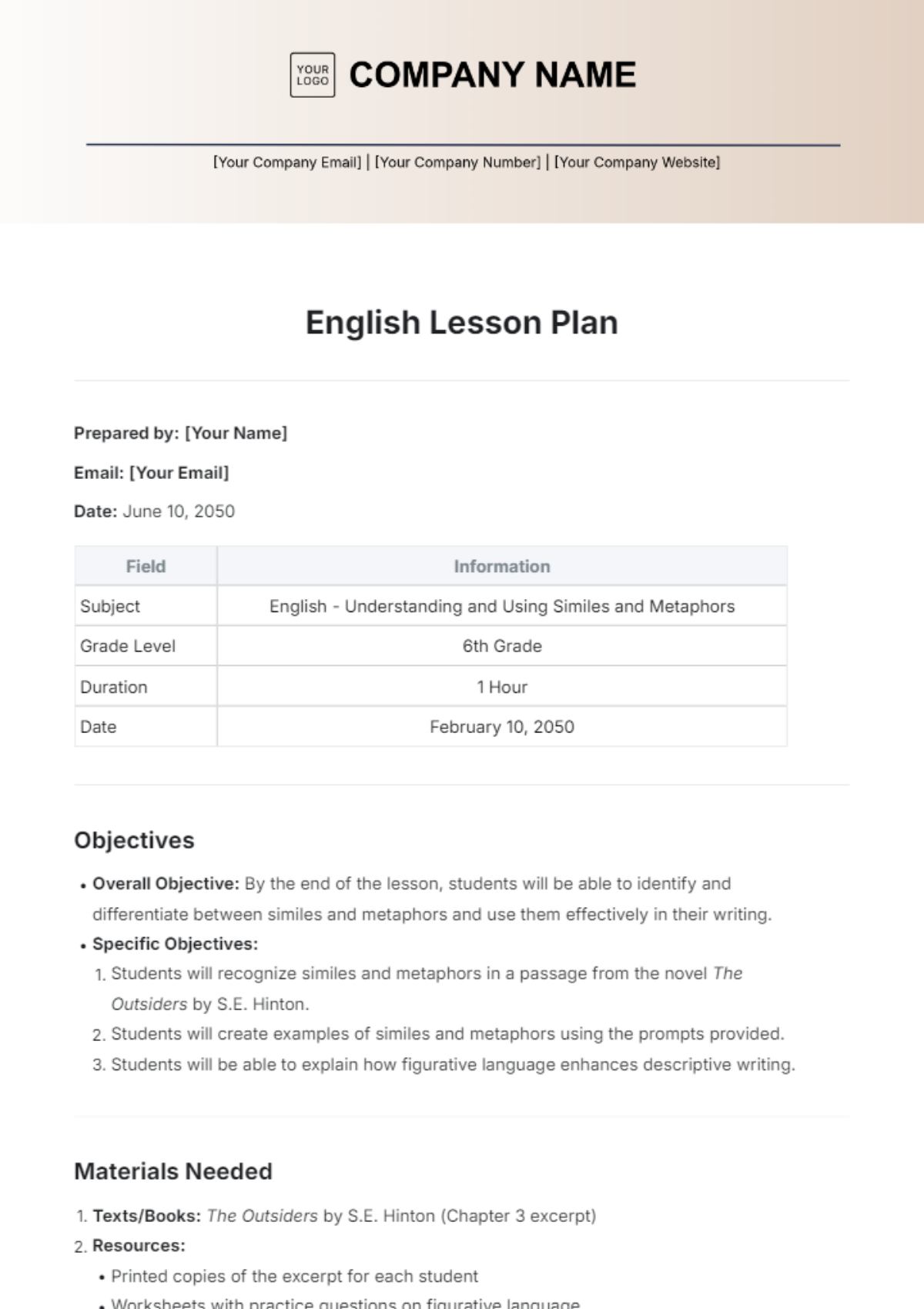
Prepared by: [Your Name]
Email: [Your Email]
Date: June 10, 2050
Field | Information |
|---|---|
Subject | English - Understanding and Using Similes and Metaphors |
Grade Level | 6th Grade |
Duration | 1 Hour |
Date | February 10, 2050 |
Objectives
Overall Objective: By the end of the lesson, students will be able to identify and differentiate between similes and metaphors and use them effectively in their writing.
Specific Objectives:
Students will recognize similes and metaphors in a passage from the novel The Outsiders by S.E. Hinton.
Students will create examples of similes and metaphors using the prompts provided.
Students will be able to explain how figurative language enhances descriptive writing.
Materials Needed
Texts/Books: The Outsiders by S.E. Hinton (Chapter 3 excerpt)
Resources:
Printed copies of the excerpt for each student
Worksheets with practice questions on figurative language
Whiteboard/markers
Highlighters (for student use)
Technology: Projector for class-wide reading of the passage, PowerPoint with examples of similes and metaphors, access to Smartboard
Introduction (5-10 minutes)
Warm-up Activity: Begin with a quick, relatable discussion: "Think about how you describe something awesome or fun. Have you ever said something like, ‘That car was fast as lightning!’ or ‘He’s a bear in the morning before his coffee’? What do you notice about these sentences?"
Link to Prior Knowledge: Students have previously learned about adjectives and descriptive writing. Today, we'll take it a step further by using similes and metaphors to make descriptions even more vivid.
Stating the Lesson Objective: "Today, we’re going to explore how authors use similes and metaphors to bring their writing to life. By the end of today’s lesson, you’ll be able to identify similes and metaphors in The Outsiders and create your own to enhance your writing."
Lesson Procedure
Part 1: Direct Instruction (10-15 minutes):
A. Teacher's Role:
Definition and Explanation: Write the definitions of simile and metaphor on the board.
Simile: A comparison using “like” or “as” (e.g., "Her smile was as bright as the sun.")
Metaphor: A comparison that says one thing is another (e.g., "Time is a thief.")
Examples from The Outsiders: Display the passage from Chapter 3 on the Smartboard:
“Johnny’s eyes were as wide as saucers when he heard the news.”
“The street was a jungle, and I was a lone wolf.”
Highlight the simile and metaphor in these examples. Discuss how the comparisons create strong images in the reader’s mind.
Modeling Identification:
Read a paragraph aloud and model how to identify similes and metaphors by underlining them on the board.
B. Student's Role:
Listen attentively and take notes.
Engage with the teacher's examples by suggesting how the comparisons affect the meaning and mood of the text.
Part 2: Guided Practice (15-20 minutes):
A. Activity: Group Work - Identifying Similes and Metaphors
Divide students into small groups of 3-4.
Provide each group with a printed excerpt from The Outsiders (different from the example used in direct instruction).
Task: Each group highlights similes in one color and metaphors in another using the highlighters provided.
Follow-up: Groups will share their findings with the class, explaining how they identified each figurative language device and what it adds to the description.
B. Teacher's Role:
Circulate among groups, assisting with clarification and ensuring students correctly identify similes and metaphors.
Ask probing questions: "Why do you think the author chose to use a metaphor here? How does it change the way we view the character?"
C. Students' Role:
Collaborate with group members.
Actively participate in the class-wide discussion, sharing and justifying their findings.
Assessment (10-15 minutes)
A. Formative Assessment:
Individual Practice: Provide each student with a worksheet that includes a variety of sentences. Some sentences contain similes, some contain metaphors, and others contain neither.
Task: Students will identify whether each sentence contains a simile or metaphor and then write a short explanation.
Example question:
Sentence: "The wind was a howling wolf, fierce and untamed."
Question: Is this a simile or metaphor? Why?
B. Teacher's Role:
Collect the worksheets and provide immediate feedback, either through class discussion or by reviewing the answers together.
Conclusion (5 minutes)
Summary of Lesson: "We’ve looked at how similes and metaphors create powerful images in writing. Similes use 'like' or 'as,' while metaphors directly compare two things without those words. Now you can identify them in what you read—and use them in your writing to make your descriptions more interesting."
Exit Ticket/Reflection: On a sticky note, students will write one new simile or metaphor they created during the lesson (e.g., "My homework was as hard as a rock.") and place it on the board as they leave.
Differentiation
For Advanced Students:
Challenge them to find more subtle forms of figurative language (e.g., personification) or write a paragraph using at least two metaphors and two similes.
For Struggling Students:
Provide additional examples and offer sentence stems like, "The cat was as ___ as a ___," to help them complete their similes.
Pair them with a peer mentor to work on the group activity.
Homework/Follow-up Activity
Assignment:
Write a short paragraph (5-6 sentences) describing your favorite season. Use at least two similes and one metaphor in your description. Underline them.
Due Date: Next class (October 9, 2050).
Reflection (Post-lesson)
What went well?
What could be improved?
Did students meet the objectives?
Next steps: (E.g., Continue figurative language study with a focus on other forms such as personification and hyperbole.)
- 100% Customizable, free editor
- Access 1 Million+ Templates, photo’s & graphics
- Download or share as a template
- Click and replace photos, graphics, text, backgrounds
- Resize, crop, AI write & more
- Access advanced editor
Enhance your teaching efficiency with this English Lesson Plan Template from Template.net. This fully customizable and editable template is designed to simplify your lesson planning process. Utilize the AI Editor Tool for seamless adjustments, ensuring your plans are always accurate and engaging. Ideal for educators aiming to optimize their curriculum effortlessly.
